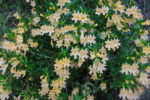Cultivating the Wild: Water Needs of Natives
Cultivating the Wild: Water Needs of Native Plants
-Darlene Ward
The native plant garden has different requirements for water than a vegetable or cutting garden. It is tempting to believe that all native plants are drought resistant, but of course that isn’t true. Consider the many different habitats in which we find native plants.
Here are a few important considerations when purchasing, planting and maintaining native plants.
Understand water needs.
Native plants grow in a variety of wild environments. Some plants naturally grow in riparian areas or the fog belt of the coast, where there is moisture in the soil and in the air. These plants, such as seep monkey flower and stream orchids, will need regular summer water in the valley and foothills. Plants that grow in the hot inland valley or the desert have adapted to a lack of summer water, growing more slowly and often going dormant during the dry season. They are usually labeled “drought resistant.” This category of low-water plants includes some that should not receive summer water, due to susceptibility to plant pathogens and root rot in the presence of moist soil and warm temperatures. Flannel bush, woolly blue curls and some members of the lily family do best without summer water. There are other natives that are very adaptable and will happily accept water along with your other garden plants, including many of our more common natives, such as lupines and poppies.
Group companion plants together.
One answer to the gardener’s dilemma of how much to water is to group together plants with similar needs. This means the gardener must do some research before planting. The Living Wild book describes the water needs of individual plants with simple icons provided as a guide. Along with putting the “right plant in the right place,” selecting the right neighbor for each plant is important. California Native Plants for the Garden by Carol Bornstein, David Fross and Bart O’Brien, offers lists of companion plants in the garden, both for water and for beauty.
Give special attention to young plants.
Special care must be given to monitoring the rootball of new plants. The surrounding soil may be moist, but the rootball may be very dry, especially in clay soil. Planting in the fall is ideal as occasional rain helps to keep the rootball moist, but even then it needs to be checked regularly. Young native plants must receive water while they are getting established. Generally, this means more frequent irrigation for the first two to even three years. Reduce water as the plant matures.
Water deeply to reach the roots.
The method of applying water is not as important as the amount of water. Drip irrigation, soaker hoses and micro-sprinklers all work, given enough run-time. Overhead water is less desirable, especially mid-day watering when the water evaporates readily. However, many plants will respond to being hosed off monthly to wash away dust and pollen. I prefer to do this in the morning so plants can dry off before evening, and I avoid leaving mid-day water drops on leaves for they can act as a magnifying glass that concentrates the sun’s rays and burns the leaves.
It works best to manually control the irrigation system since occasional deep watering with periods of drying out is better than mindlessly following a timed schedule. Consistently moist soil, combined with warm temperatures, encourage pathogens and soil-born fungi that cause root rot, which can quickly shorten a plant’s life. If a plant looks wilted, check the root zone. Do not apply water if the roots are moist. Perhaps there is some root rot starting and adding more water to moist soil will make it worse. It may simply be that tender new growth wilts in the hot sun and will perk up in the cool of the evening.
Summary
Native plants vary in their water needs. You can help them flourish beautifully by learning about their natural tendencies, observing their general appearance, checking the soil to monitor its moisture, providing deep watering when water is required and adapting the frequency of water to the age of the plant. Although native plants grow easily in the wild, they need the correct amount of water when added to the garden setting. May we have the wisdom to observe their natural habitat and learn how to cultivate the wild.





